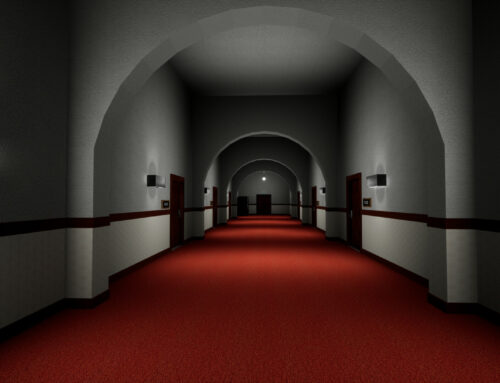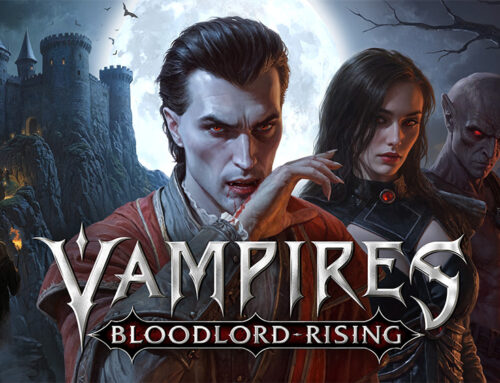William Friedkin brought the ancient Christian rite of exorcism into the public consciousness when he released his film adaptation of William Peter Blatty’s novel to terrified audiences in 1973. Now, a new generation looks to push the boundaries of terror with the burgeoning medium of virtual reality and a new challenger has arisen from that same source to re-ignite that sense of dread with The Exorcist: Legion VR. From the team that brought us the cerebral horror A Chair in A Room: Greenwater, industry veterans whose first foray into VR began on the original Oculus Rift development kit, The Exorcist: Legion VR was initially released almost 2 years ago and has since been ported to the most recent generation of headsets like the Oculus Quest and Valve Index. I find VR experiences to be far more viscerally scary than anything on film but I was still curious as to whether this could elicit the same sort of reaction in a more cynical modern audience.
The Exorcist: Legion VR puts you in the shoes of a Boston homicide detective as you investigate a string of seemingly unrelated global events surrounding sudden bouts of madness and visions of demons. Your hunt for the source of these mysterious happenings (hint: it starts with a “P” and ends with a “zuzu”) will take you through a church, an asylum, A Haitian hospital, and a tomb deep below the sands of Mesopotamia. To aid in the effort to send the princes of Hell back from whence they came is the standard-issue toolkit for any professional exorcist, a crucifix and holy water, along with a saltwater spray and a quickly-depleting oil lamp. There are elements of action-adventure here in the vein of something like Resident Evil 7 but given the distinct tools with which you are expected to handle the threat (demons don’t respond to firearms) this game takes a much more puzzle-heavy approach up until the climax of each of its five chapters, where the cornered demon lashes out in direct confrontation. Each of these chapters is roughly 10 minutes in length, though they can last much longer if you’re going for 100% completion or end up getting stuck trying to trigger the next sequence. With frequent use of the hint button, which highlights the next objective for a few seconds, I could see all 5 chapters easily b eing speed run in under 30 minutes.
eing speed run in under 30 minutes.
The puzzles themselves are enjoyable, if not all that challenging. I didn’t get 100% on any of the chapters, so there are puzzles left that I was simply unaware of, but of the ones I did complete, most are pretty straightforward in their setup and don’t require searching for clues outside of their immediate vicinity. I didn’t feel particularly clever in figuring most of them out but at least their simplicity kept things moving. What was less enjoyable, and where you’ll be spending a good chunk of your time in The Exorcist: Legion VR, were the moments spent running around in circles trying to grab anything and everything in the hopes that will entice the demon to show up. Eventually, I resorted to using the hint button whenever my next objective was not apparent, reasoning that simply knowing what I need to interact with shouldn’t matter if the puzzle requires logic to solve, which ended up improving my experience considerably.
If not for the payoff, that climactic battle with the demon that caps off every chapter, The Exorcist: Legion VR would be a pretty unexceptional puzzle game that I would have a hard time recommending to anyone outside of fans of the genre. But when this game gets going, it’s horror magic. Even on the Quest, which takes a graphical hit largely in the complexity of its materials as seen in these side-by-side comparisons with the desktop version, the horror sequences here are a potent mix of anxiety-inducing build-up and deviously-effective jump scares that nearly buckled me on multiple occasions. Beyond their fundamental terror, which is something that VR naturally excels at, there is a great deal of creativity in the construction of these sequences as they make the most of the medium’s ability to fully hijack your senses, both visually and aurally. As the world transforms around you, with every turn gradually distorting your world into a waking nightmare, the excellent positional audio assails you with distorted fragments of demonic suggestion and the final moments of the possessed they’ve left in their wake.
 While it can certainly get the blood flowing in ways that few games can, this is not an action game and that’s a good thing because it seems almost purposefully clunky. There is no better demonstration of this than how you go about accessing your exorcist tools—double-tapping the m enu button (or holding it for about 2 seconds) brings up a hollowed-out book that contains your gear, then you need to press the trigger to open the book, then you grab the item with your other hand, and finally, make sure to double-tap the menu button again to close your inventory or you will be unable to move. This is required whenever you want to change items and once you have chosen an item, you must continue to hold the grip button as long as you wish to use it or you’ll drop it on the ground. Initially, I hated this and I still kind of do but I began to appreciate it for the same reason people appreciate the so-called “tank controls” from the original Resident Evil games. Those games were objectively not easy to control, certainly not compared to later titles which adopted a more modern first-person action approach, but their clunkiness created a sense of vulnerability; you not only had a zombie to contend with but an awkward controller scheme. The same can be said of The Exorcist: Legion VR’s inventory system which makes you dread having to switch items in the middle of a confrontation but in doing so emulates the feeling I imagine an ordinary priest might feel when feverishly shuffling through their bag of relics to find the appropriate tool to vanquish a rampaging demon. Even the best VR games can be rendered unplayable if you can’t physically tolerate playing them and in this regard, The Exorcist: Legion VR checks all boxes for comfortable play with both free and teleportation-based movement (or a hybrid of both) and a number of options for different intervals of rotation which should give both the most resilient and sickness-prone VR gamer the ability to dial in their ideal experience.
While it can certainly get the blood flowing in ways that few games can, this is not an action game and that’s a good thing because it seems almost purposefully clunky. There is no better demonstration of this than how you go about accessing your exorcist tools—double-tapping the m enu button (or holding it for about 2 seconds) brings up a hollowed-out book that contains your gear, then you need to press the trigger to open the book, then you grab the item with your other hand, and finally, make sure to double-tap the menu button again to close your inventory or you will be unable to move. This is required whenever you want to change items and once you have chosen an item, you must continue to hold the grip button as long as you wish to use it or you’ll drop it on the ground. Initially, I hated this and I still kind of do but I began to appreciate it for the same reason people appreciate the so-called “tank controls” from the original Resident Evil games. Those games were objectively not easy to control, certainly not compared to later titles which adopted a more modern first-person action approach, but their clunkiness created a sense of vulnerability; you not only had a zombie to contend with but an awkward controller scheme. The same can be said of The Exorcist: Legion VR’s inventory system which makes you dread having to switch items in the middle of a confrontation but in doing so emulates the feeling I imagine an ordinary priest might feel when feverishly shuffling through their bag of relics to find the appropriate tool to vanquish a rampaging demon. Even the best VR games can be rendered unplayable if you can’t physically tolerate playing them and in this regard, The Exorcist: Legion VR checks all boxes for comfortable play with both free and teleportation-based movement (or a hybrid of both) and a number of options for different intervals of rotation which should give both the most resilient and sickness-prone VR gamer the ability to dial in their ideal experience.
At $25 (or $5 per chapter if bought separately) for a game that can be completed casually in an hour, The Exorcist: Legion VR can’t compare to most traditional games in value per hour but this is true of most VR games and certainly true of any made exclusively for owners of high-end VR headsets. If you accept that as a given in the current market, however, a case can be made for this game to those who are willing to give it a chance to get where it’s going. For those that own a Quest and have some means to access their PC VR library, either through owning a Rift, Sidequest, or the upcoming Oculus Link, The Exorcist: Legion VR includes cross-buy, granting access to both platforms with a single purchase. This would not be my go-to option for introducing people to horror in VR given the relative length of the overt horror to the more subdued puzzle-solving and narrative sequences but as a complete package, it’s still one of the best available for the Quest and its highs rank among some of the best I’ve experienced to date.







